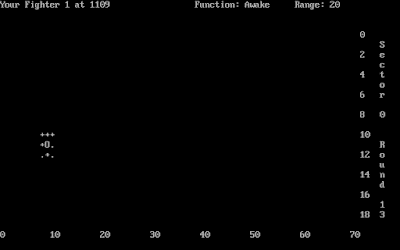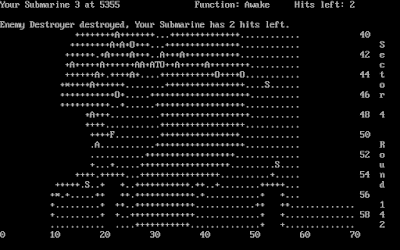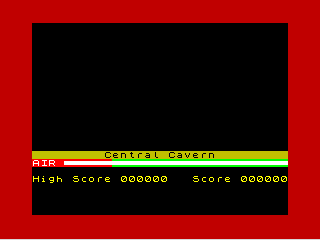Septem 8, 11344 GY. 1810 millichrons GST. It is my third day shipwrecked on an abandoned settlement of an uncharted ocean world, once part of the Second Union, but long forgotten since the collapse. My sole companion is a natively manufactured utility droid B-19-7 who answers to "Floyd." The former inhabitants' architecture and technology is well preserved despite untold years of neglect, but much is in various states of disrepair. I have secured a source of unlimited vittling in a kitchen facility, and gained access to transportation between a dormitory complex and a science campus, where my hope of survival may lie with repairing and operating its machinery.
Ahab, ensign seventh class.
When I left off, I had made some good progress in Planetfall. I'd mapped out most of the complex, found transportation between the two main sites "Kalamontee" and "Lawanda," secured a place to eat and sleep, repaired some of the systems, and gained an inkling of what's going on here.
Usually
when I decide to take a break and post a write-up, it's because I'm
stuck and have no idea what to do next. But this time, there's quite a
bit for me to do, now that I've activated the teleporter and can
transport myself freely. The game hasn't felt this open since my initial
landing.
The
eastern site Lawanda, the science complex, has a computer in the
library lobby that is full of useful but annoying to read background
information. I spent some time perusing every subject available.
- This planet was settled by Second Union colonists long, long ago, so long that their existence passed into legend and was only recently confirmed by archaeologists. A "Graat Hiaatus" plunged their society into a dark age, but they emerged on the other side into an era of fantastic technology and artistic achievements.
- Recent technological advancements include the ability to cure nearly any disease, and to put patients with incurable ones in stasis, hydroponic farming efficient enough to replace all conventional agriculture, and advanced robotics. It notes that robots of the past were highly specialized (one robot sees, one hears, etc.), but are now designed to be multipurpose.
- Geographically, nearly half of the planet was covered with land, or at least it was the last time the computer was updated. Climate change must have hit hard since!
- A pandemic known as "Xe Dizeez" is somehow linked to cryogenics research. Two complexes were constructed high up in the mountains to freeze and monitor the entire population of the planet, and automatically revive them when a vaccine could be administered.
- Plugs for Infocom's back-catalog.
- Piloting the helicopter requires an access card and a control panel key, which can be found in Transportation Storage.
- Xe Dizeez's early symptoms include high fever and hypersomnia. Death always occurs within ten days of experiencing first symptoms.
A third reel with instructions on how to fix repair robots was sealed off in a radiation lab further to the east. Entering without protection works about as well as you might expect.
There remained a number of problems with no obvious solution yet.
- Opening a locked door north of the rec room, seemingly operated by combination lock.
- Finding a light source to explore the transportation supply room, where I could expect to find the helicopter's keys.
- Accessing the planetary reactor. To the east of the lobby is an electronically locked door, and darkened stairs lead down.
- Locating the other side of the conference room's locked door.
- Fixing the Project Control system.
- Interacting with a strange, rippling mural in the ProjCon office.
- Retrieving the brown spool from the radiation lab.
- Retrieving the miniaturization access card from the mutant-infested bio lab.
But another set of problems' solutions did present themselves, now that I had free reign of the place.
- Operating the "Betty" shuttle to see if it goes anywhere new.
- Repairing the Course Control system with parts and tools from the dormitory campus.
- Replacing a laser's battery with a fresh one found in the science campus.
First things first, though. I teleported back to Kalamontee to get some sleep and to refill my canteen and stomach. The game notified me I was feeling weaker, and possibly developing a fever. Great.
Next morning, the fever was getting worse. I took some medicine found in the infirmary for some temporary Dizeez raleef, and swapped the laser's old battery with the new one. I grabbed pliers and a 90Ω bedistor, teleported to Lawanda, and replaced the bad one in course control, clearing the warning there. And then I rode Betty, but it just transported me back to Kalamontee.
Well, that's it for the easy problems. Time to look at the hard ones.
First, I went back to the rec area. A dial could be turned to any number from 0 to 1000. The only number I remember seeing here was the computer room's output referencing a section 384, but nothing special happened when I turned the dial to that number.
There are two dark areas, the transportation supply room where they keep the helicopter's keys, and the stairs to the reactor access. As in Zork, grues eat you if you go to dark places without a light source, and I didn't have one. My newly functional laser emitted blue light, but didn't seem to illuminate darkness.
The locked door by the reactor lobby did not respond to any of my keycards.
It wasn't clear what was wrong with the project control system, but again, the computer output suggested a malfunction in section 384. What to do about that remained unclear. A red light here indicated a computer malfunction, and Floyd told me Achilles used to teleport into the computer.
A mural in the adjacent office had a strange ripple effect, but I couldn't find any way to interact with it.
Inside the radiation lab is a lamp and a repair manual for repair droids - both of which would be very useful right now! But entering is deadly, and there don't seem to be any hazmat suits available. Floyd can't be ordered to retrieve them; he just says "after you."
Lastly, there's the bio lab, and what follows is probably Planetfall's most iconic scene. Here, Floyd offered to snatch the card inside, claiming the mutants couldn't hurt him. As he instructed, I opened the door, quickly shut it behind him, and re-opened as he frantically knocked, letting him through and slamming it shut before the mutants could get out with him. Floyd had retrieved the keycard, but the mutants had torn him to pieces.
Floyd's
death is well written and poignant, but it doesn't tug on my
heartstrings for a few reasons. First, I've been inoculated against this
kind of manipulative sentimentality long ago. Call me a heartless
curmudgeon if you like. Second, during this scene we sing Floyd his
favorite song Ballad of the Starcrossed Miner, which gets four alternating
tetrameter verses summarizing the plot of Starcross. It's practically a
running gag that every Infocom game must constantly reference every
other Infocom game, and I'm sure they thought they were terribly clever
for doing this, but at best this is cute and self-referential, and this
just doesn't seem like the time or place for it. Finally, there's
another reason that we'll get to later, but for now let me just say this
isn't my first time playing.
Anyway, with the card I could access the miniaturization booth and teleport inside the computer's damaged sector, where I found a speck of dust stuck inside a relay. Zapping it with my laser obliterates both the speck and relay - obviously this is no good, but on a reload I examined the laser and found a dial to adjust its power. Only the lowest setting can safely destroy the dust without damaging the computer.
On the way back, a gang of microbes blocked my egress! I've seen Fantastic Voyage, and what happens next isn't pleasant. Setting the dial all the way up, I shot at them repeatedly, to no effect. But I kept shooting to see what would happen - the laser got hotter, and eventually the game said they were being drawn to the heat. So I threw it over the side - I'm sure that's just great for the computer - and they followed, leaving a clear path for me to return... to an alternate receiving platform, located on the east side of the bio lab. Trotting krip.
I was in a lab office connected to the bio lab, where the mutants who eviscerated Floyd still lurked, and the only way back to the complex was through it. Looking around, I found a few buttons, one of them red and labeled "Eemurjensee Sistem" which dispensed some sort of pacifying agent into the lab, and inside a desk I found a gas mask. Wearing the mask, I pushed the button and ran through, but the mutants recovered before I could shut the door on them!
As I ran out of the bio-lock, mutants in close pursuit, an intercom blared "Revival procedure beginning. Cryo-chamber access from Project Control Office now open." So I ran there, where the strange mural slid away revealing an elevator, which I took downward, stranding the mutants.
This act ended the game.
The
elevator closes as you leave it, and you find yourself in a small,
chilly room. To the north, through a wide arch, is an enormous chamber
lined from floor to ceiling with thousands of cryo-units. You can see
similar chambers beyond, and your mind staggers at the thought of the
millions of individuals asleep for countless centuries.
In the
anteroom where you stand is a solitary cryo-unit, its cover frosted.
Next to the cryo-unit is a complicated control panel.
A door
slides open and a medical robot glides in. It opens the cryo-unit and
administers an injection to its inhabitant. As the robot glides away, a
figure rises from the cryo-unit -- a handsome, middle-aged woman with
flowing red hair. She spends some time studying readouts from the
control panel, pressing several keys.
As other cryo-units in the
chambers beyond begin opening, the woman turns to you, bows gracefully,
and speaks in a beautiful, lilting voice. "I am Veldina, leader of
Resida. Thanks to you, the cure has been discovered, and the planetary
systems repaired. We are eternally grateful."
"You will also be
glad to hear that a ship of your Stellar Patrol now orbits the planet. I
have sent them the coordinates for this room." As if on cue, a landing
party from the S.P.S. Flathead materializes nearby. Blather is with
them, having been picked up from deep space in another escape pod,
babbling cravenly. Captain Sterling of the Flathead acknowledges your
heroic actions, and informs you of your promotion to Lieutenant First
Class.
As a team of mutant hunters head for the cryo-elevator,
Veldina mentions that the grateful people of Resida offer you leadership
of their world. Captain Sterling points out that, even if you choose to
remain on Resida, Blather (demoted to Ensign Twelfth Class) has been
assigned as your personal toilet attendant.
You feel a sting from your arm and turn to see a medical robot moving away after administering the antidote for The Disease.
This
ending grates on me, with so many little contrivances. Saving the
world, fine. But we don't find out why the Feinstein exploded, making it
nothing more than a plot device without in-universe justification for
it. Becoming leader of the planet seems unwarranted and also at odds
with my duties to the Stellar Patrol. Blather's comeuppance assumes the
player is invested in hating him, and I'm really not - he just wasn't
important enough to the plot. Plus, there's no reason why command would
demote him, let alone make him my personal P.L.O.
It's that childish fantasy of seeing the bully that tormented you in
school fail at adult life, grow up fat ugly and single, and get stuck in
a menial position and having to personally lick your boots, only not as
plausible.
It gets worse.
A
team of robot technicians step into the anteroom. They part their
ranks, and a familiar figure comes bounding toward you! "Hi!" shouts
Floyd, with uncontrolled enthusiasm. "Floyd feeling better now!" Smiling
from ear to ear, he says, "Look what Floyd found!" He hands you a
helicopter key, a reactor elevator card, and a paddleball set. "Maybe we
can use them in the sequel..."
I despise this trope. In general, I hate when a happy ending just undoes anything sad that happened earlier - sacrifice has no weight if you can just get it back later - but it's so much worse when it involves bringing the dead back to life, whether through magic, science, or fake-out reveal. It's the irreversibly of death that makes it sad, and if the rules suddenly declare that can just fix someone, then death is merely an inconvenience.
She
turns to you and, with a strained voice says, "You have fixed our
computer and a Cure has been discovered, and we are grateful. But alas,
it was all in vain. Our planetary course control system has
malfunctioned, and the orbit has now decayed beyond correction. Soon
Resida will plunge into the sun."As
other cryo-units in the chambers beyond begin opening, the woman turns
to you, bows gracefully, and speaks in a beautiful, lilting voice. "I am
Veldina, leader of Resida. Thanks to you, the cure has been discovered,
and the planetary systems repaired. We are eternally grateful.""Unfortunately,
a second ship from your Stellar Patrol has been destroyed by our
malfunctioning meteor defenses. I fear that you are stranded on Resida,
possibly forever. However, we show our gratitude by offering you an
unlimited bank account and a house in the country."
"Unfortunately,
a second ship from your Stellar Patrol has come looking for survivors,
and because of our malfunctioning communications system, has given up
and departed. I fear that you are stranded on Resida, possibly forever.
However, we show our gratitude by offering you an unlimited bank account
and a house in the country."
GAB Rating: Good. My dislike for Planetfall's ending doesn't undermine the good time that I had reaching it. Everyone talks about Floyd - he didn't do much for me, but Planetfall's greatest success is in creating a believable, lived-in setting for a video game, in a way that most adventures since strive for, but none before really succeeded at. Exploring Resida evoked a sense of wonder that Zork and Starcross before it couldn't with their (in-universe justified) artificial worlds. Even if a good number of the rooms were corridors, bedrooms, and toilets, the world as a whole felt plausible, with a history that I couldn't wait to discover. And the well crafted critical path ensured that I did at just a gradual enough pace to satisfy while keep me wanting more.
It isn't a perfect game by any means. As I noted earlier, Meretzky can't really commit to the comedic tone that the manual and opening chapter suggest. The game's tone is overall pretty grim, and even horrific at times, with bits of humor reserved for Floyd's antics and some Easter eggs. Puzzles are a bit on the easy side, and while on one hand this meant I never got stuck, it also meant that I never felt clever for figuring anything out. And there are all these little things that drag the game's otherwise steady pace to a halt - the inventory limits, the constant need to eat, to drop what you're doing and go back to the barracks to sleep, or to refill your canteen. The many separate passcards and the need to carry the right ones with you whenever you want to go anywhere, and having to type out "slide <adjective> card through slot" every single time you need to pass through a door that needs one, specifying the specific one you need to use, was a chore.
I also feel that the several red herrings - the dark rooms you can never enter, the helicopter you can never use, the impassable radiation lab, and the microfilm spools giving clues that you can't use - may have been intended to enhance verisimilitude, but these had the opposite effect on me, reminding me that Meretzky put these things here to mislead. I mean, what are the odds that a deadly radiation lab would just happen to have two things in it that you want? This isn't a bad thing per se; we give signposting a break even when there's no in-universe justification for it, so why not have misleading signposts too, for the sake of challenge? It just feels at odds with the intended design.
Overall, though, Planetfall is
one of Infocom's better games, a sign of their increasingly focused
commitment storytelling through setting, and a great sign of things to
come, not just from Incofom, but out of the adventure genre as a whole.














































